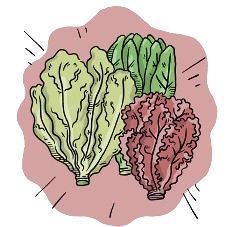Learn to grow microgreens at home, join Grow It Local +
How to grow
Join Our Community
Learn to grow and cook healthy, delicious, organic food at home by joining our seasonal grow-alongs.
Join Our Community
Learn to grow and cook healthy, delicious, organic food at home by joining our seasonal grow-alongs.
Growing Tips and Tricks
Location:
Mixed leaf lettuce thrives in cooler temperatures. Choose a location in your garden that receives partial sun to dappled shade. It can tolerate full sun in cooler climates, but in hot weather, some shade during the hottest part of the day can help prevent bolting. The soil should be well-draining, loose, and rich in organic matter.
Watering:
Mixed leaf lettuce prefers consistent and even moisture, but like other lettuces, it’s essential to avoid overwatering, as it can lead to root rot. Water the plants regularly, keeping the soil evenly moist. In hot weather, you may need to water daily, while in cooler weather, watering once or twice a week might be sufficient.
Problems:
Bolting: As with other lettuce varieties, mixed leaf lettuce can bolt in response to heat or other stress factors. To prevent bolting, plant in cooler temperatures and provide some shade in hot weather.
Pests: Watch out for common lettuce pests, such as aphids, slugs, and snails. Use organic insecticides or traps to manage pest infestations.
Diseases: Lettuce can be susceptible to diseases like downy mildew and powdery mildew. To prevent these issues, avoid overhead watering and provide good air circulation around the plants.
Tipburn: Tipburn can affect lettuce leaves, causing the edges to turn brown due to calcium deficiency or fluctuations in watering. Maintain consistent soil moisture and ensure adequate calcium levels to prevent tipburn.
Harvest:
Mixed leaf lettuce can be harvested as baby greens when the leaves are young and tender, or you can wait for them to reach a larger size for a more substantial harvest. To harvest, either snip individual leaves with scissors, leaving the center of the plant to continue growing, or cut the entire plant at the base to encourage regrowth for additional harvests.
Background
Lettuce has a long history that traces back to ancient civilizations. The wild ancestor of cultivated lettuce, is believed to have originated in the Mediterranean region. Early forms of lettuce were consumed for their medicinal properties rather than as a culinary vegetable.
Ancient Egyptians and Romans are credited with cultivating and developing different lettuce varieties, leading to the domestication of wild lettuce. Through trade and exploration, lettuce spread across various regions, becoming a prominent ingredient in European and Asian cuisines.
The concept of mixing different lettuce types to create diverse and visually appealing salads likely evolved over time as people experimented with combining various leafy greens.
Health Benefits
Eating homegrown, organic, mixed leafs is good for you!
The diverse mix of greens provides a range of vitamins (A, C, K) and minerals (iron and calcium).
Mixed leaves contain antioxidants that combat free radicals and reduce inflammation. Its high fibre content aids digestion and supports a healthy gut. Regular consumption of mixed leaf lettuce can contribute to weight management and improved heart health.
Patch to plate
Variety is the spice of life and it’s hard to resist the visual feast of a big bowl full of mixed lettuce leaves. You can eat these delicious greens for any meal of the day, here’s a few pieces of culinary inspiration to get your kitchen creative juices flowing:
- Lightly dressed with olive oil and lemon juice and served along side a big bowl of creamy scrambled eggs and sourdough toast.
- Served alongside roasted veggies, grains, sprouts and avocado as a part of a healthy buddha bowl
- Dressed with olive oil, white wine vinegar and whole grain mustard, served as a fresh salad alongside a roast dinner.




